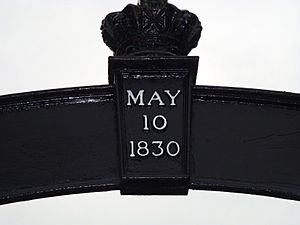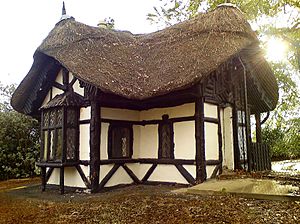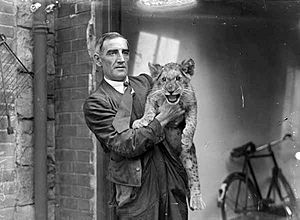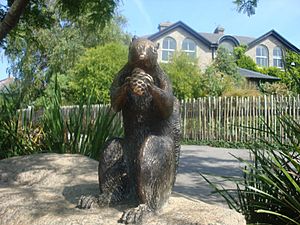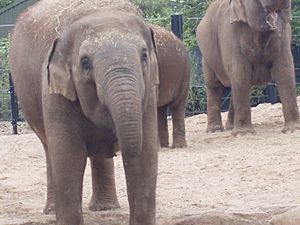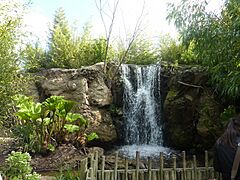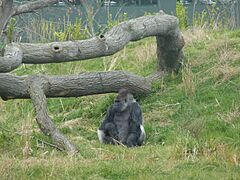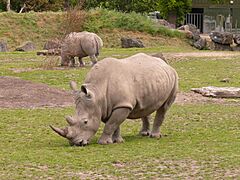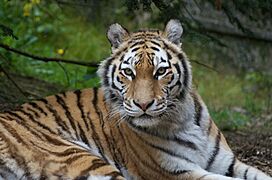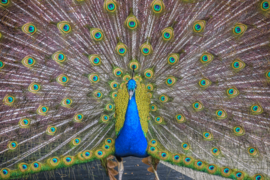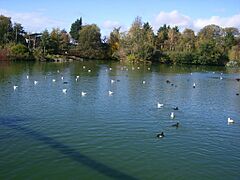Dublin Zoo facts for kids
 |
|
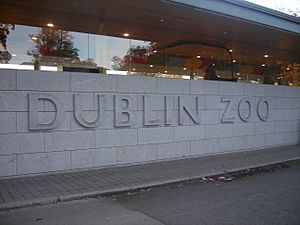
Dublin Zoo entrance
|
|
| Date opened | 1 September 1831 |
|---|---|
| Location | Dublin, Ireland |
| Land area | 28 ha (69 acres) |
| Coordinates | 53°21′14″N 6°18′14″W / 53.35389°N 6.30389°W |
| No. of animals | 400 |
| No. of species | 100 |
| Annual visitors | 1+ million |
| Memberships | British and Irish Association of Zoos and Aquariums, European Association of Zoos and Aquaria, World Association of Zoos and Aquariums |
| Major exhibits | African Plains, Asian Forests, Family Farm, Himalayan Hills, Kaziranga Forest Trail, Sea Lion Cove, South American House, Wolves in the Woods, World of Primates, Zoorassic World |
Dublin Zoo (Irish: Zú Bhaile Átha Cliath) is a famous zoo located in Phoenix Park in Dublin, Ireland. It's one of Dublin's most popular places to visit. The zoo was started in 1830 and opened its doors in 1831.
Today, Dublin Zoo works hard to protect animals and their homes. They run special breeding programs to help save endangered species. Their main goal is to help save animals around the world. The zoo covers about 28 hectares (that's like 70 acres!) inside Phoenix Park.
It has many different areas, like the African Savanna and Zoorassic World. The zoo is home to about 400 animals from 100 different species. More than a million people visit Dublin Zoo every year!
History of Dublin Zoo
Early Days: The 1800s
The Royal Zoological Society of Dublin started the zoo on May 10, 1830. The zoo, first called the Zoological Gardens Dublin, opened to the public on September 1, 1831. Its first animals, 46 mammals and 72 birds, came from London Zoo and the Royal Menagerie at the Tower of London.
At first, it cost one shilling to get in. But Dublin Zoo did something different: they lowered the price to just one penny on Sundays. This made the zoo popular with everyone, including families with less money.
In 1833, the first small entrance building was built. It cost £30 and also housed staff. You can still see this old, thatch-roofed building near the current entrance. In 1838, to celebrate Queen Victoria's coronation, the zoo had a special open day. An amazing 20,000 people visited that day!
The zoo got its first giraffe in 1844. In 1855, it bought its first pair of lions, which had cubs for the first time in 1857. Even famous people, like former US President Ulysses S. Grant, came to see Dublin's famous lions. In 1876, reptiles got their own house, and the first tearooms opened in 1898.
Challenges and Growth: The 1900s
During the 1916 Easter Rising, a zoo employee's son, Jack Flood, stayed at the zoo to care for the animals. He and two other young keepers faced food shortages. Sadly, Jack died soon after from the Spanish flu.
In 1903, an elephant named Sita accidentally killed her keeper. She had to be put down by police. Times of war also caused problems for the zoo. During the 1916 Easter Rising, the zoo ran out of meat. To keep the lions and tigers alive, some other animals had to be used for food. A lion named Slats was born at the zoo in 1919. He was one of many lions filmed by Metro-Goldwyn-Mayer in 1928 to become their famous mascot, Leo.
Between 1989 and 1990, the zoo faced serious money problems and almost closed. The government then started giving the zoo a yearly grant, like other zoos in Europe. In 1997, 13 hectares (about 32 acres) of land near the lake in Áras an Uachtaráin (the President's home) were added. This greatly increased the space for the animals.
Modern Times: The 2000s
In 2002, a 28-year-old hippo named Linda swallowed a tennis ball thrown by a visitor. It got stuck inside her, and she sadly died.
In 2005, the Kaziranga Forest Trail opened. This area is now home to eleven Asian elephants. In 2009, the African Savannah opened in the African Plains section. Here you can see giraffes, zebras, ostriches, and southern white rhinos.
Dublin Zoo welcomed 963,053 visitors in 2010. By 2015, it was the third most popular place to visit in Ireland, with over 1.1 million visitors. In 2015, a well-known western lowland gorilla named Harry passed away. Harry had many offspring, helping to save his species.
A TV show called The Zoo is filmed at Dublin Zoo. It started in 2010 and shows what life is like for the animals and keepers. In November 2020, during the COVID-19 pandemic, the public donated over 2 million euro in just two days to help the zoo. This showed how much people cared about the animals.
In 2022, some concerns were raised about animal care, but the zoo strongly denied these claims.
Animals and Exhibits
After some concerns about animal housing, a "Plan for the Future of Dublin Zoo" was created. In 1994, the government gave the zoo a lot of money for improvements. New themed areas were planned. The first, World of Primates, opened in 1996. The African Plains opened in 2001.
African Plains
African Plains is a large area that looks like Africa. It opened in 2001 and covers 13 hectares. The main part is the "African Savanna," where ostriches, scimitar-horned oryx, southern white rhinoceros, Rothschild's giraffes, and Grant's zebras all share a big outdoor space.
The Gorilla Rainforest opened in 2012. It's home to a group of western lowland gorillas. You can see a male gorilla named Bangui, two adult females, Kafi and Vana, and two young females, Asali and Kambiri.
Other animals in African Plains include chimpanzees, African wild dogs, hippopotamus, sooty mangabeys, and okapis. There's also an Africa-themed restaurant and a gift shop. A baby scimitar-horned oryx was born here in December 2016.
Wolves in the Woods
Wolves in the Woods is an exhibit where you can see grey wolves.
Himalayan Hills
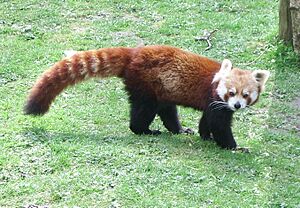
This area is designed to look like a Nepalese village. It houses two species that live in the Himalayas: the snow leopard and the Red panda.
Zoorassic World (Reptiles)
Dublin Zoo's first Reptile House opened way back in 1876. In July 2017, Zoorassic World opened as the new home for the zoo's reptiles. It even has a replica of a T.Rex fossil!
Asian Forests
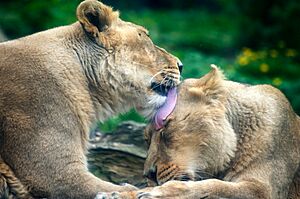
Asian Forests first opened in 1998. It has four different areas. One area looks like the Gir forest in India and is home to Asiatic lions. Another area looks like the rainforests of Sumatra, Indonesia, and houses Sulawesi crested macaques.
The third area is for Amur tigers and looks like the forests of Amur in Russia, China, and North Korea. The fourth area is for dholes, which are wild dogs, and looks like forests in India and South Asia.
The Kaziranga Forest Trail
Opened in June 2007, the Kaziranga Forest Trail is where Dublin Zoo's Asian elephants live. It's named after the Kaziranga National Park in India. The zoo has 11 elephants, including adult females Bernhardine and Yasmin, and their daughters Asha and Anak.
The area has a waterfall and two pools for the elephants. There are also sheltered spots for visitors to watch and a playground for kids. The elephants share their home with a pair of blackbuck. Many young elephants have been born here, including Kavi, Ashoka, Samiya, Zinda, Avani, Kabir, and Sanjay.
South American House
Dublin Zoo's South American House is home to many different animals from Central and South America. You can see golden lion tamarins, Goeldi's marmosets, Linnaeus's two-toed sloths, squirrel monkeys, and pygmy marmosets.
World of Primates
The World of Primates opened in 1996 and is home to many kinds of apes and monkeys. This area has several man-made islands in a natural lake. The islands are connected by wooden bridges to sleeping areas on the shore.
Some islands have climbing frames for the animals. Parts of the islands are set aside for plants to grow, making them look more natural. There are also areas with bark and other materials where animals can search for food.
Large windows in the sleeping areas let visitors see the animals up close. However, there are also places where the animals can hide if they want privacy.
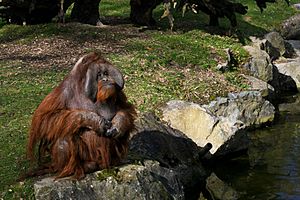
The islands are home to siamangs, red ruffed lemurs, ring-tailed lemurs, spider monkeys, and Celebes crested macaques. These animals can go outside day and night all year round. The zoo has been very successful in breeding primates on these islands, especially the Celebes crested macaques, lemurs, and siamangs.
In 2008, an orangutan briefly escaped her enclosure but was quickly found. That same year, an orangutan named Jorong was seen helping an injured bird chick from a pond. He gently moved the bird to the grass, and a video of this rescue became very popular online.
Family Farm
The Family Farm (which used to be called City Farm) first opened in 1999 and was updated in 2010. This area helps teach people about modern Irish farming. It's a project between Dublin Zoo and Agri Aware, a group that helps people understand farming and food in Ireland.
Animals you can see at the Family Farm include Greyface Dartmoor sheep, pygmy goats, Tamworth pigs named Rose and Ginger, Australorp chickens, and Holstein Friesian cows.
Sea Lion Cove
The President of Ireland, Michael D. Higgins, opened the new Sea Lion Cove in June 2015. This habitat is home to California sea lions: three females named Cassie, Florence, and Seanna, and one male named Nico. It's the biggest new project at Dublin Zoo in recent years. The cove looks like the sea lions' natural home and has a special water cleaning system.
Nocturnal House
A new nocturnal house opened in July 2023 near Sea Lion Cove. It is home to Aye-Aye lemurs, which are active at night. These lemurs are an endangered species.
Other Animals
Dublin Zoo also has other animals that are not part of a specific themed area. These include Chilean flamingos, meerkats, South American tapirs, and waldrapp ibises.
Conservation Efforts
Dublin Zoo is part of a worldwide effort to breed and protect endangered species. It is a member of the European Endangered Species Programme (EEP). This program helps zoos work together to save animals in Europe. For each species, there's a special coordinator who helps create breeding groups. The goal is to keep the animal populations healthy and diverse.
In November 2023, the zoo opened the National Centre for Species Survival. This center works with the IUCN (International Union for Conservation of Nature) to help protect species.
Dublin Zoo helps manage the EEP for the golden lion tamarin and the Moluccan cockatoo. It also cares for animals like Goeldi's monkey and the white-faced saki, which are part of EEPs managed by other zoos. The zoo's main focus is on protecting animals, which means breeding them, doing research, and teaching people about them.
Rodrigues Fruit Bats
Rodrigues fruit bats are one of the endangered species at Dublin Zoo. These bats eat fruit, and because of this, they are very important to rainforests. Bats cannot digest the seeds of the fruit they eat. So, when they poop, the seeds come out with natural fertilizer. Without bats, many rainforest trees would not be able to spread their seeds and grow.
The Rodrigues fruit bats are now in the Roberts House (also called the bird house), which is located near the ring-tailed lemurs.
Golden Lion Tamarins
This tiny monkey is named for the long, gold-colored hair around its head, which looks like a lion's mane. The golden lion tamarin is one of the rarest primates in the world. Like many other tamarins in South America, they are in danger of disappearing from their natural homes. Dublin Zoo is part of an international breeding program and helps fund researchers who study tamarins in Brazil.
The forests where golden lion tamarins live are being cut down for wood, farms, and cities. Sometimes, only very small patches of forest are left, which are too small for the tamarins to survive in. In the past, tamarins were also caught to be sold as pets or for research. You can find the golden lion tamarins in the South American house.
Moluccan Cockatoos
Dublin Zoo keeps the European studbook for Moluccan cockatoos. A studbook is like a special record book for all the animals of a certain species in zoos in a region. It includes information like the animal's gender, age, and parents. This information helps zoos decide which birds should breed together to get the best mix of genetics. This helps keep the captive population as healthy as possible. Moluccan cockatoos are beautiful birds with white and pink feathers and a pink crest. This cockatoo is also on the endangered species list.
Gallery
-
Gorilla habitat.
See also
 In Spanish: Zoológico de Dublín para niños
In Spanish: Zoológico de Dublín para niños


